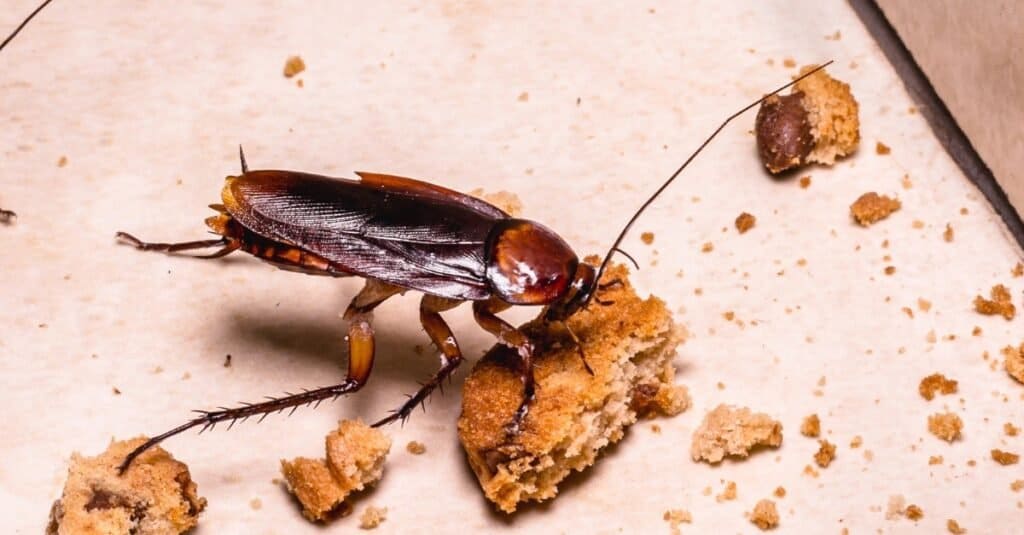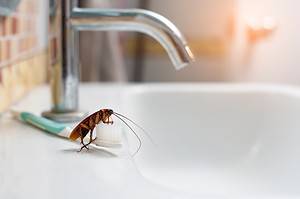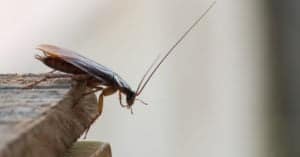Roaches are nocturnal and often scare people who want to sit outside and enjoy a warm summer evening. But, roaches have adaptations that ensure they can thrive at night and during the day. Here, we explore the sleep behavior of roaches and discuss why their evolution means they are nocturnal and flexible enough to be diurnal sometimes.
Explaining the Sleep Behavior of Roaches

Despite being active during daytime hours at times, roaches are nocturnal and most active at midnight.
©iStock.com/RHJ
Roaches are nocturnal insects, but their sleeping patterns are hard to study and track. However, the National Library of Medicine researchers found that roaches have three different activity states:
- Locomotion
- Immobility
- Limb and antenna movements without locomotion
During the day or a 12-hour light, the roach’s locomotion, also known as movement, is low. The roach’s activity increases during the night or over a 12-hour dark period. Their activity is highest during the middle of the night. Researchers found that cockroaches are immobile a few hours before the night ends, throughout the day, and after an extended period of being active. Scientists view their immobile state as their sleeping pattern. During this time, roaches do not sleep but rather rest.
Why Are Roaches Nocturnal?
These insects are nocturnal because of their circadian rhythm. For some creatures, like humans, their circadian rhythm makes them active during the day when there is sunlight. Once the sun sets, the human body produces hormones to induce sleep. But with roaches, the opposite takes place.
Roaches are adapted to thrive at night, which is why they prefer low-light settings over brighter ones. The Department of Entomology at the National Taiwan University found that the Pigment Dispersing Factor (PDF) significantly regulates nightly activity levels in roaches. PDF is a neuropeptide which is a chemical in the brain that controls the locomotive behavior based on the roach’s circadian rhythms.
Roaches Prefer the Dark

Roaches prefer the nighttime because it is safer, protecting them from predators.
©PRATYUSH PATTANAIK/Shutterstock.com
Roaches are adapted to feed, reproduce, and gather safely in the dark because the nighttime offers various advantages. Examples of these advantages are:
- The nighttime is quieter. These insects are prey to many animals and are easily frightened. Because the night is more peaceful, roaches can hear loud sounds easier and can quickly identify danger.
- The nighttime is cooler. Roaches can function during the heat of the day, but it is easier to find food and mate in cooler temperatures.
- Many of its predators are diurnal. These insects are small and are quick snacks for many animals. Some roach predators include small mammals, birds, reptiles, and turtles. Luckily, most of these predators are active during the day.
- Roaches prefer mating during the nighttime. Cockroaches can mate during the day, but the evening is quieter and safer, making mating much safer. During the night, cockroaches can find a mate without undue interruption, fertilize the eggs, and plant them in a safe space.
- Finding food is more accessible at night. Their feeding pattern matches their circadian rhythm, so roaches function better at night, making hunting and scavenging ideal.
Are Roaches Scared of Light?
It’s a common misconception that roaches are scared of light. If you switch on a light in a dark room with cockroaches, they will scatter for cover. This behavior may seem like they are scared of light. But exposure to light or sunlight does not scare roaches or harm them.
Cockroaches avoid light because it startles them or makes them uncomfortable. This response is pretty common in most animals. A sudden source of blinding bright light is unnatural and tends to surprise any animal. Roaches also know that a sudden light source likely means that danger or a predator is nearby, which is an excellent reason to take action to protect themselves.
Roaches Do Not Like Constant Light
Although roaches scatter when exposed to light, constant light can also have a negative impact on them. A study in the Journal of Experimental Biology explains how continuous light can interfere with the roach’s circadian rhythm.
Researchers performed a study and placed artificial light sources near roaches at different intensities. The study found that when exposed to light, even at low intensity, the cockroaches were unlikely to come out of hiding compared to the lights being off. The study also discovered that the roach’s rest and activity cycles were negatively affected when the lights were on at night.
Roaches Can See in the Dark

Roaches have light-sensitive cells in wraparound eyes and fine hairs on their antennae that can detect movements and vibrations invisible to people.
©gan chaonan/Shutterstock.com
The Journal of Experimental Biology found that roaches have light-sensitive cells in their eyes. Cockroaches use these light-sensitive cells to detect visual signals in the dark. The journal study discovered that roaches react to movements in dim light, which people cannot see.
Cockroaches can also navigate and detect motion at night without moonlight. Roach’s eyes wrap around their heads, allowing them to see behind them without turning or angling their heads. Because of this, these insects can absorb more light and see better in the dark.
Cockroaches also use their antennae to see in the dark. Tiny hairs cover their antennae, which are sensitive to vibrations in the air. Because of this sensitivity, roaches can detect motions and movements in their surroundings without seeing them. If the cockroach identifies the motion as a threat, it will scatter. Their antennae can detect specific scents, allowing them to notice threats through smell.
Roaches Might Also Be Active During the Day
Cockroaches prefer being active at night but are also diurnal when necessary. If these insects are hungry or live in a busy area, these factors may encourage daylight activity. Another fascinating fact about cockroaches is that they can live for extended periods without eating because they are cold-blooded.
Cold-blooded creatures do not need as much food as warm-blooded creatures to maintain their internal temperatures. But, if roaches have not eaten for a while or live in an area with limited food sources, they may become desperate and start scavenging during the day for food. These insects even venture out in crowds during the day if desperate enough for food.
Roaches breed and multiply fast. Females produce as many as 400 eggs in their life, often leading to infestations. When there is an infestation, food sources decrease, and there is often little space to live comfortably. This consequence often leads to cannibalism which means some roaches will leave the area to look for a safer space. The search for a new home can then happen during the day.
How Do Roaches Find Food at Night?
Roaches have adaptations that help them thrive and hunt at night. Examples are eyes that wrap around their heads for a broader vision, light-sensitive cells, and antennae. These attributes help them locate prey but also other food. Roaches are opportunistic feeders and will feed on almost anything edible in their path.
Roaches Want To Enter Homes at Night
A home is a haven for roaches as it has food and water sources, is warm, and often has nooks and crannies where cockroaches can hide and breed. To prevent cockroaches from entering your home, you should ensure that there is no exposed food and that your home is clean. Cockroaches use their antennae to pick up scents and smell exposed food or dirt in your home. Roaches also look for places to hide and breed in your home, such as:
- Cluttered spaces
- Cracks in walls and under the house
- Spaces with wiring or plumbing
To prevent roaches from turning your home into their haven, seal any possible entrances into these spaces and keep your home and garden clean and uncluttered.
Nocturnal vs. Diurnal: What’s The Difference?
Navigate to Nocturnal vs. Diurnal: What’s The Difference? for further information about the nocturnal and diurnal phenomenon in various living creatures.
Up Next – All About Roaches
- Cockroach
- How To Get Rid of Roaches Overnight
- Cockroach Milk: Yes, This is a Real Thing — But Why?
- Cockroach vs Beetle: The 5 Key Differences
The photo featured at the top of this post is © PitukTV/Shutterstock.com
Sources
- John Wiley & Sons, Inc, Available here: https://resjournals.onlinelibrary.wiley.com/doi/pdf/10.1111/phen.12163
- National Library of Medicine, Available here: https://www.ncbi.nlm.nih.gov/pmc/articles/PMC5312013/
- ABC Home & Commercial Services, Available here: https://www.abchomeandcommercial.com/blog/why-do-cockroaches-come-out-at-night/
- Science Direct, Available here: https://www.sciencedirect.com/science/article/pii/B9780128229637000372
- Batzner Pest Control, Available here: https://www.batzner.com/resources/blog-posts/why-do-cockroaches-come-out-at-night/
- The Company of Biologists, Available here: https://journals.biologists.com/jeb/article/217/23/4111/12896/Cockroaches-pool-light-signals-to-see-in-dark
- National Library of Medicine, Available here: https://www.ncbi.nlm.nih.gov/pmc/articles/PMC6262936/
- PEST SAMURAI, Available here: https://pestsamurai.com/do-cockroaches-sleep/
- CochroachZone.com, Available here: https://www.cockroachzone.com/why-are-cockroaches-more-active-at-night/
Thank you for reading! Have some feedback for us? Contact the AZ Animals editorial team.






